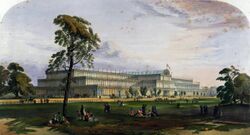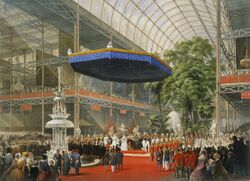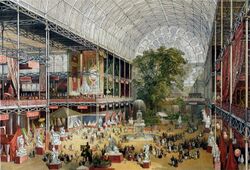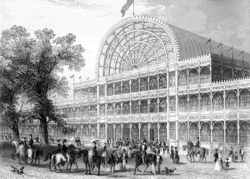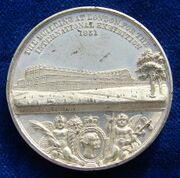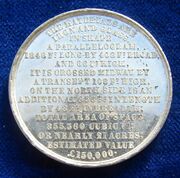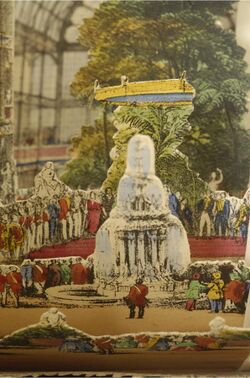The Great Exhibition
Topic: History
 From HandWiki - Reading time: 8 min
From HandWiki - Reading time: 8 min
The Great Exhibition of the Works of Industry of All Nations or The Great Exhibition, sometimes referred to as the Crystal Palace Exhibition in reference to the temporary structure in which it was held, was an international exhibition that took place in Hyde Park, London, from 1 May to 15 October 1851. It was the first in a series of World's Fairs, exhibitions of culture and industry that became popular in the 19th century, and it was a much anticipated event. The Great Exhibition was organized by Henry Cole and Prince Albert, husband of the reigning monarch, Queen Victoria. It was attended by famous people of the time, including Charles Darwin, Samuel Colt, members of the Orléanist Royal Family and the writers Charlotte Brontë, Charles Dickens, Lewis Carroll, George Eliot, Alfred Tennyson and William Makepeace Thackeray. Music for the opening was under the direction of Sir George Thomas Smart and the continuous music from the exhibited organs for the Queen's procession was "under the superintendence of William Sterndale Bennett".
Background
The Exposition des produits de l'industrie française (Exhibition of Products of French Industry) organized in Paris, France, from 1798 to 1849 were precursors to the Great Exhibition of 1851 in London.
The Great Exhibition of the Works of Industry of All Nations was organized by Prince Albert, Henry Cole, Francis Henry, George Wallis, Charles Dilke and other members of the Royal Society for the Encouragement of Arts, Manufactures and Commerce as a celebration of modern industrial technology and design. It was arguably a response to the highly effective French Industrial Exposition of 1844: indeed, its prime motive was for Britain to make "clear to the world its role as industrial leader".[1] Prince Albert, Queen Victoria's consort, was an enthusiastic promoter of the self-financing exhibition; the government was persuaded to form the Royal Commission for the Exhibition of 1851 to establish the viability of hosting such an exhibition. Queen Victoria and her family visited three times. Although the Great Exhibition was a platform on which countries from around the world could display their achievements, Britain sought to prove its own superiority. The British exhibits at the Great Exhibition "held the lead in almost every field where strength, durability, utility and quality were concerned, whether in iron and steel, machinery or textiles."[2] Britain also sought to provide the world with the hope of a better future. Europe had just struggled through "two difficult decades of political and social upheaval," and now Britain hoped to show that technology, particularly its own, was the key to a better future.[1]
Sophie Forgan says of the Exhibition that "Large, piled-up ‘trophy’ exhibits in the central avenue revealed the organisers’ priorities; they generally put art or colonial raw materials in the most prestigious place. Technology and moving machinery were popular, especially working exhibits." She also notes that visitors "could watch the entire process of cotton production from spinning to finished cloth. Scientific instruments were found in class X, and included electric telegraphs, microscopes, air pumps and barometers, as well as musical, horological and surgical instruments."[3]
A special building, nicknamed The Crystal Palace, or "The Great Shalimar",[4] was built to house the show. It was designed by Joseph Paxton with support from structural engineer Charles Fox, the committee overseeing its construction including Isambard Kingdom Brunel, and went from its organisation to the grand opening in just nine months. The building was architecturally adventurous, drawing on Paxton's experience designing greenhouses for the sixth Duke of Devonshire. It took the form of a massive glass house, 1851 feet (about 564 metres) long by 454 feet (about 138 metres) wide and was constructed from cast iron-frame components and glass made almost exclusively in Birmingham[5] and Smethwick. From the interior, the building's large size was emphasized with trees and statues; this served, not only to add beauty to the spectacle, but also to demonstrate man's triumph over nature.[1] The Crystal Palace was an enormous success, considered an architectural marvel, but also an engineering triumph that showed the importance of the Exhibition itself.[2] The building was later moved and re-erected in 1854 in enlarged form at Sydenham Hill in south London, an area that was renamed Crystal Palace. It was destroyed by fire on 30 November 1936.[4]
Six million people—equivalent to a third of the entire population of Britain at the time—visited the Great Exhibition. The average daily attendance was 42,831 with a peak attendance of 109,915 on 7 October.[6] The event made a surplus of £186,000 (£18,370,000 in 2015),[7], which was used to found the Victoria and Albert Museum, the Science Museum and the Natural History Museum. They were all built in the area to the south of the exhibition, nicknamed Albertopolis, alongside the Imperial Institute. The remaining surplus was used to set up an educational trust to provide grants and scholarships for industrial research; it continues to do so today.[8]
The Exhibition caused controversy as its opening approached. Some conservatives feared that the mass of visitors might become a revolutionary mob,[9] whilst radicals such as Karl Marx saw the exhibition as an emblem of a capitalist fetishism of commodities. King Ernest Augustus I of Hanover, shortly before his death, wrote to Lord Strangford about it:
The folly and absurdity of the Queen in allowing this trumpery must strike every sensible and well-thinking mind, and I am astonished the ministers themselves do not insist on her at least going to Osborne during the Exhibition, as no human being can possibly answer for what may occur on the occasion. The idea ... must shock every honest and well-meaning Englishman. But it seems everything is conspiring to lower us in the eyes of Europe.[10]
In modern times, the Great Exhibition is a symbol of the Victorian Age, and its thick catalogue, illustrated with steel engravings, is a primary source for High Victorian design.[11] A memorial to the exhibition, crowned with a statue of Prince Albert, is located behind the Royal Albert Hall.[12] It is inscribed with statistics from the exhibition, including the number of visitors and exhibitors (British and foreign), and the profit made.
Exhibits
The official descriptive and illustrated catalogue of the event lists exhibitors not only from throughout Britain but also from its 'Colonies and Dependencies' and 44 'Foreign States' in Europe and the Americas. Numbering 13,000 in total, the exhibits included a Jacquard loom, an envelope machine, kitchen appliances, steel-making displays and a reaping machine that was sent from the United States.[13]
- The Koh-i-Noor, meaning the "Mountain of Light," was the world's largest known diamond in 1851. It was one of the most popular attractions of the India exhibit and was acquired in 1850 as part of the Lahore Treaty.
- The Daria-i-Noor, one of the rare pale pink diamonds in the world.
- The early 8th-century Tara Brooch, discovered only in 1850, the finest Irish penannular brooch, was exhibited by the Dublin jeweller George Waterhouse along with a display of his fashionable Celtic Revival jewellery.
- Alfred Charles Hobbs used the exhibition to demonstrate the inadequacy of several respected locks of the day.
- Frederick Bakewell demonstrated a precursor to today's fax machine.
- Mathew Brady was awarded a medal for his daguerreotypes.
- William Chamberlin, Jr. of Sussex exhibited what may have been the world's first voting machine, which counted votes automatically and employed an interlocking system to prevent over-voting.[14]
- The first modern pay toilets were installed, with 827,280 visitors paying the 1 penny fee to use them. The toilets remained even after the exhibition was dismantled. "Spending a penny" became a euphemism for using a toilet.[15]
- Firearms manufacturer Samuel Colt demonstrated his prototype for the 1851 Colt Navy and also his older Walker and Dragoon revolvers.
- The Tempest prognosticator, a barometer using leeches, was demonstrated at the Great Exhibition.
- The America's Cup yachting event began with a race held in conjunction with the Great Exhibition.
- Gold ornaments and silver enamelled handicrafts fabricated by the Sunar caste from Sind, British India.
- C.C. Hornung of Copenhagen, Denmark, showed his single-cast iron frame for a piano, the first made in Europe.
- "The Trophy Telescope", so called because it was considered the "trophy" of the exhibition.[16] The main lens of 11 inches (280mm) aperture and 16 feet (4.9m) focal length was manufactured by Ross of London. The German equatorial mounting was made by Ransome & May of Ipswich.
- The instrument maker, J S Marratt exhibited a five-feet achromatic telescope and a transit theodolite used in surveying, tunnelling, and for astronomical purposes.
- Asprey Kingwood and Ormolu mounted lady's dressing case with silver-gilt contents bearing the 'Annie' cipher.
Admission fees
Admission prices to the Crystal Palace varied according to the date of visit, with ticket prices decreasing as the parliamentary season drew to an end and London traditionally emptied of wealthy individuals. Prices varied from three guineas (£311.05 in 2015)[7] (two guineas for a woman) for a season ticket, or £1 per day (for the first two days only), then reducing to five shillings per day (until May 22).[17] The admission price was then further reduced to one shilling (£4.94 in 2015),[7] per day – except on Fridays, when it was set at two shillings and six pence and on Saturdays when it remained at five shillings.[17] The one-shilling ticket proved most successful amongst the industrial classes, with four and a half million shillings (£22,217,549 in 2015),[7] being taken from attendees in this manner.[18] Two thousand five hundred tickets were printed for the opening day, all of which were bought.[9]
Souvenirs: Lane's Telescopic Views
The Great Exhibition of 1851 encouraged the production of souvenirs, the Lane's Telescopic Views which provided a three-dimensional view of the Great Exhibition of 1851. These were paper souvenirs that were made of printed lithographic cards which were hand-coloured and held together by cloth to give a three-dimensional view of the Great Exhibition. These views offered a miniature view of the Crystal Palace Exhibition when one viewed the cards through the peep hole on the front cover. Visitors purchased these souvenirs so that they could relive the experience of going to the exhibition.
See also
- List of world's fairs
- 1862 International Exhibition, held in London.
- Festival of Britain
- Prince Albert's Model Cottage
References
- ↑ 1.0 1.1 1.2 Kishlansky, Mark, Patrick Geary and Patricia O'Brien. Civilization in the West. 7th Edition. Vol. C. New York: Pearson Education, Inc., 2008.
- ↑ 2.0 2.1 Ffrench, Yvonne. The Great Exhibition; 1851. London: Harvill Press, 1950.
- ↑ Forgan, Sophie (10 February 2000), "A compendium of Victorian culture", Nature 403 (6880): 596, doi:10.1038/35001134, Bibcode: 2000Natur.403..596F
- ↑ 4.0 4.1 "The Great Exhibition of 1851". Duke Magazine. November 2006. http://www.dukemagazine.duke.edu/dukemag/issues/111206/depgal2.html. Retrieved 30 July 2007.
- ↑ James Harrison, ed (1996). "Imperial Britain". Children's Encyclopedia of British History. London: Kingfisher Publications. p. 131. ISBN 978-0-7534-0299-3.
- ↑ Appletons' annual cyclopaedia and register of important events of the year: 1862. New York: D. Appleton & Company. 1863. p. 412. https://archive.org/stream/1862appletonsan02newyuoft#page/n419/mode/1up.
- ↑ 7.0 7.1 7.2 7.3 UK Retail Price Index inflation figures are based on data from Clark, Gregory (2017). "The Annual RPI and Average Earnings for Britain, 1209 to Present (New Series)". MeasuringWorth. https://measuringworth.com/ukearncpi/. Retrieved 2 February 2020.
- ↑ The Royal Commission for the Exhibition of 1851. "About Us". http://www.royalcommission1851.org.uk/about.html. Retrieved 1 November 2008.
- ↑ 9.0 9.1 Newth, A.M. (1967). Britain and the World: 1789-1901. New York: Penguin Books. p. 97. ISBN 978-0-14-080304-4.
- ↑ Van der Kiste 2004, pp. 206–207.
- ↑ Official Catalogue of the Great Exhibition of the Works of Industry of All Nations. 1851. https://www.google.com/books?id=OfMHAAAAQAAJ&source=gbs_summary_s&cad=0.
- ↑ "Memorial to the exhibition". Royal Institute of British Architects. http://preview-riba.contensis.com/LibraryDrawingsAndPhotographs/Albertopolis/TheStoryOf/GreatExhibition/MemorialToTheExhibition.aspx. Retrieved 18 October 2014.
- ↑ "The Great Exhibition at the Crystal Palace" . Victorian Station. Retrieved 3 February 2009.
- ↑ "The Great Exhibition," Manchester Times, 24 May 1851.
- ↑ "Spending a Penny for the Monkey Closet". https://findery.com/californiawilliam/notes/spending-a-penny-for-the-monkey-closet.
- ↑ Smyth, C. P. (1862). "Trophy Telescope at Wester Elchies". Monthly Notices of the Royal Astronomical Society 23: 1. doi:10.1093/mnras/23.1.1. Bibcode: 1862MNRAS..23....1S.
- ↑ 17.0 17.1 Leapman, Michael (2001). The World For A Shilling. pp. 72.
- ↑ "Entrance Costs to the Great Exhibition". Fashion Era. http://www.fashion-era.com/the_great_exhibition.htm#Entrance%20Costs%20To%20The%20Great%20Exhibition. Retrieved 3 February 2009.
Further reading
- Auerbach, Jeffrey A. (1999). The Great Exhibition of 1851: A Nation on Display. Yale University Press. ISBN 978-0-300-08007-0.
- Gibbs-Smith, Charles Harvard (1981) [1951]. The Great Exhibition of 1851 (Second ed.). London: HMSO. ISBN 978-0-11-290344-4.
- Greenhalgh, Paul (1988). Ephemeral Vistas: The Expositions Universelles, Great Exhibitions and World's Fairs, 1851–1939. Manchester University Press. ISBN 978-0-7190-2299-9.
- Leapman, Michael (2001). The World for a Shilling: How the Great Exhibition of 1851 Shaped a Nation. Headline Books. ISBN 978-0-7472-7012-6.
- Dickinson's Comprehensive Pictures of the Great Exhibition of 1851. Dickinson Brothers. London. 1854.
External links
- Official website of the BIE
- 1851 map Map of London showing the site of the Great Exhibition in Hyde Park. MAPCO
- "Memorials of the Great Exhibition" (cartoon) Cartoon series from Punch magazine
- Charlotte Bronte's account of a visit to the Great Exhibition mytimemachine.co.uk
- "Great Exhibition of 1851 and its legacy". Architecture and history. Royal Institute of British Architects. http://www.architecture.com/LibraryDrawingsAndPhotographs/Albertopolis/TheStoryOf/GreatExhibition/TheGreatExhibitionof1851.aspx. Retrieved 14 December 2010.
- Great Exhibition Collection in the National Art Library Victoria and Albert Museum
- "In Our Time" BBC radio programme discussing the Great Exhibition and its impact. Originally broadcast 27 Apr 2006
- Royal Engineers Museum Royal Engineers and the Great Exhibition
- "Watercolours of the Great Exhibition". Paintings and Drawings. Victoria and Albert Museum. http://www.vam.ac.uk/collections/paintings/past_exh/greatEx_watercolours/index.html. Retrieved 13 November 2007.
 KSF
KSF